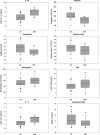A three-component biomarker panel for prediction of dengue hemorrhagic fever
- PMID: 22302872
- PMCID: PMC3269290
- DOI: 10.4269/ajtmh.2012.11-0469
A three-component biomarker panel for prediction of dengue hemorrhagic fever
Abstract
Dengue virus infections are a major cause of morbidity in tropical countries. Early detection of dengue hemorrhagic fever (DHF) may help identify individuals that would benefit from intensive therapy. Predictive modeling was performed using 11 laboratory values of 51 individuals (38 DF and 13 DHF) obtained on initial presentation using logistic regression. We produced a robust model with an area under the curve of 0.9615 that retained IL-10 levels, platelets, and lymphocytes as the major predictive features. A classification and regression tree was developed on these features that were 86% accurate on cross-validation. The IL-10 levels and platelet counts were also identified as the most informative features associated with DHF using a Random Forest classifier. In the presence of polymerase chain reaction-proven acute dengue infections, we suggest a complete blood count and rapid measurement of IL-10 can assist in the triage of potential DHF cases for close follow-up or clinical intervention improving clinical outcome.
Conflict of interest statement
Disclosure: Josefina Garcia, Eric S. Halsey, Patrick J. Blair, Claudio Rocha, Isabel Bazan, and Tadeusz J. Kochel are military service members or employees of the U.S. Government. This work was prepared as part of their official duties. Title 17 U.S.C. §105 provides that ‘Copyright protection under this title is not available for any work of the United States Government.’ Title 17 U.S.C. §101 defines U.S. Government work as a work prepared by a military service member or employee of the U.S. Government as part of that person's official duties.
Figures




References
-
- Graham RR, Juffrie M, Tan R, Hayes CG, Laksono I, Ma'roet C, Erlin, Sutaryo, Porter KR, Halstead SB. A prospective seroepidemiologic study on dengue in children four to nine years of age in Yogyakarta, Indonesia I. studies in 1995–1996. Am J Trop Med Hyg. 1999;61:412–419. - PubMed
-
- Guzman MG, Kouri G, Bravo J, Valdes L, Vazquez S, Halstead SB. Effect of age on outcome of secondary dengue 2 infections. Int J Infect Dis. 2002;6:118–124. - PubMed
-
- Thomas L, Verlaeten O, Cabie A, Kaidomar S, Moravie J, Najioullah F, Plumelle Y, Fonteau C, Dussart P, Césaire R. Influence of the dengue serotype, previous dengue infection, and plasma viral load on clinical presentation and outcome during a dengue-2 and dengue-4 co-epidemic. Am J Trop Med Hyg. 2008;78:990–998. - PubMed
Publication types
MeSH terms
Substances
Grants and funding
LinkOut - more resources
Full Text Sources
Other Literature Sources
Miscellaneous

